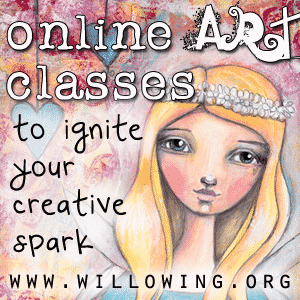Art friend, we often see the results of inspiration & creativity online, the darker flip-side seems to not be talked about so often. I’m hoping that sharing the following vulnerable musings will help you not feel so alone when sometimes the inspiration doesn’t come.
The way I approach making art comes from within, and at times it simply doesn’t come. Does that ever happen to you?
When I notice this happening, I feel several things:
- Pressure. Why can’t I create? Why can’t I be consistent?
- Guilt. Will people who expect to see my art be disappointed? What if I can’t deliver what I promised?
- Fear. Will it ever come back? Am I just kidding myself thinking I’m an artist?
I start thinking that maybe I should approach art in the results focussed way. I’m a fairly competent painter; I could paint cute animals or watercolour landscapes or just do crafty things like bookbinding. I could just produce and focus on creating a massive output. But when I sit down to try I can’t. The heaviness comes tenfold, because on some level I know that I am avoiding something.
Recently I noticed something that I do, or maybe something I experience is a better way of putting it. When I’m in a creative period, I feel like I’ve cracked the code, I’ve unlocked something in myself, I’ll never have to worry again about not feeling creative! Then, sometimes gradually, sometimes suddenly, the feeling disappears and I’m in a creative dry spell. During the dry spell I feel like it will never change. I have run out of ideas, run out of motivation and this is it, the inspiration will never come back.
It’s curious to experience these extremes, especially when my memory tells me that I’ve been through both phases many times, so I can always trust that the current phase doesn’t last forever. It’s as if what I’m experiencing is the immutable Truth and no reasoning or logical thinking changes how I feel. As someone who has used logic to override feelings for the best part of my life, this is simultaneously frustrating and a marker of progress. I’m hoping it will change over time, where I might be able to experience both at the same time.
I wish for a future where I might be able to experience the feelings that I’m currently protecting myself from by not making art (because I do think this avoidance is borne out of self-protection). It also makes me wonder about when to let things rest and be soft to myself or when to push through and force myself to create. I don’t have a definitive answer for what is ‘the right thing’, but I do think ruminating on these questions is useful in and of itself.
Right now I’m trying to listen to little sparks of creativity. They don’t yet translate to actually making art again yet, but it’s little things like seeing someone’s painting and feeling inspired, or feeling excited to try something I’ve seen (a technique or colour combination) or a general feeling of “maybe I’d like to…”. Yesterday I all of a sudden felt that I might want to try an expressive self-portrait.
We’ll see. For now I am going to try to keep listening.
Dear art friend, if this sounds familiar to you, I hope you will be able to find within you a gentleness towards yourself. We’re in this together, figuring out this thing called life & creativity.





